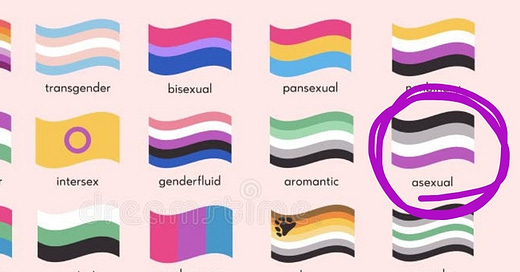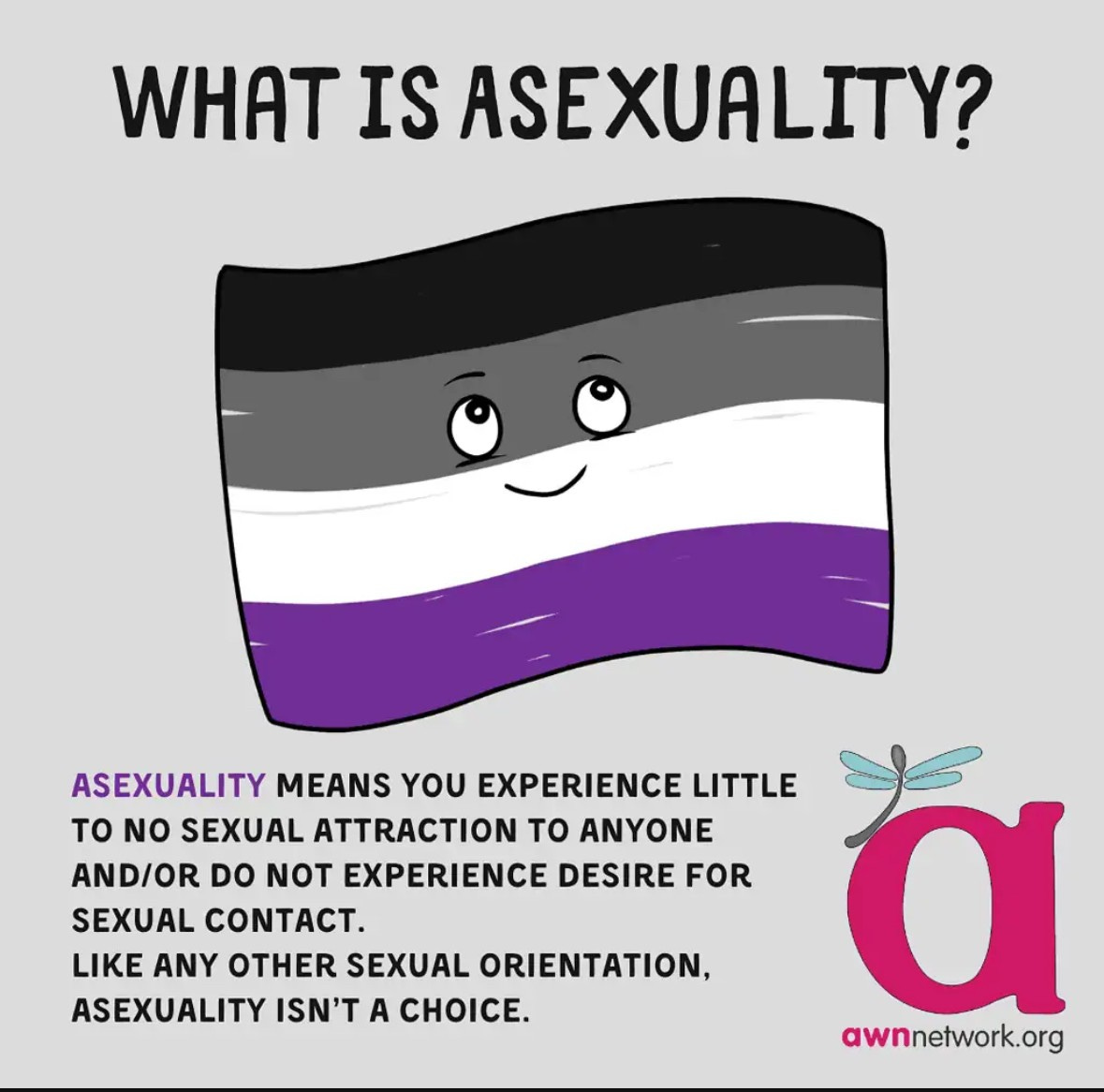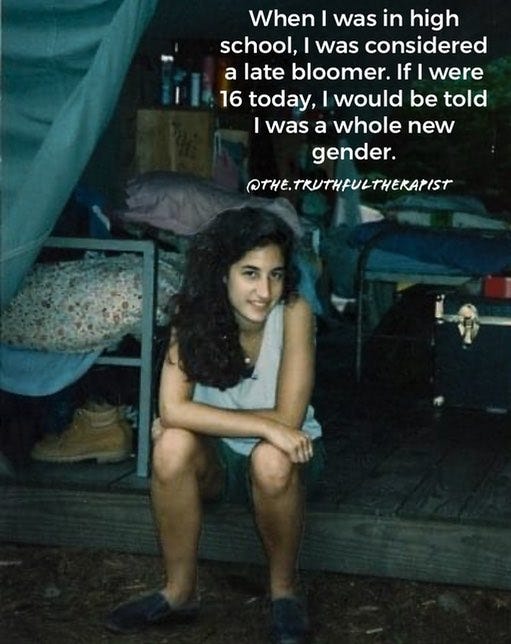On April 6, 2025, I saw many posts on X celebrating “Asexual Awareness Day.” “Asexual” is one of the countless identities currently celebrated by queer activists. This one features purple, which was my favorite color when I was a young girl.
I was a late bloomer and didn’t have boyfriends in high school. My liberal mom always asked me about the boys I liked, and I was ashamed that I didn’t have an answer. I was already getting pigeon-holed as a lesbian because my mother was so proudly “open-minded”. There wasn’t any shame about possibly being a lesbian. However, the adult scrutiny on my budding sexuality, while I was living my most awkward years, was uncomfortable to say the least. Happily, when I was coming of age in the 80’s and 90’s, “asexual” was not a thing.
Fast forward to my early 20’s. I grew out of my awkwardness and experienced my first love. I am not asexual. However, if asexual was acknowledged by medical professionals and plastered all over the internet, I might have joined the queer community and waved the purple striped flag. My very accepting mother would have cheered it on—and I could have locked myself into a fixed identity at a time meant for growth and change.
Who are Asexual People?
According to most definitions, asexuality is defined as a sexual orientation “characterized by a lack of sexual attraction to others, meaning asexual individuals may have little or no interest in sexual activity.” (Google AI) Wow, that covers a lot of ground. I can think of a lot of people and circumstances where that may be true.
Children
The first group of “asexuals” that comes to mind is children. Most children do not feel sexual attraction. That’s because they are CHILDREN. It’s very strange and disconcerting that they are declaring an identity over normal childhood development. Teens develop at different paces; they may not remain “asexual” forever. Many grow up and change, just like I did. However, this parents.com article entitled What it Means When Your Teen Says They’re Asexual and How to Support Them advises, “When your child comes out on the sexual spectrum, believe them.” The article advises not to ask any questions. This article asserts that “There is no underlying ‘cause’ of asexuality.” Rather, it’s just the way someone is.” I respectfully disagree and believe there are many reasons besides going through normal childhood development.
People Taking Medications
Another major consideration is the number of psychotropic medications that are currently prescribed, especially to young people. According to an article on healthline.com from February 28, 2024, a new study, reports antidepressant prescriptions for young adults and adolescents increased by 64% from 2020 onward. The article asserts that “antidepressant use spiked during COVID-19.” The number of youth being placed on these drugs who will have no frame of reference for how they should feel is concerning. SSRIs are known to decrease libido and cause sexual dysfunction, and for many, sexual desire does not return. The NIH study titled Antidepressant-Associated Sexual Dysfunction: Impacts, Effects and Treatment states, “Sexual dysfunction is a common side effect of antidepressants and can have significant impact on the person’s quality of life, relationships, mental health, and recovery.”
As children were locked down, abandoned to the internet, and put on antidepressants, more began identifying as asexual. Instead of investigating or treating it, asexuality is now being celebrated with flags.
People with sexual trauma
Let’s not forget those who have experienced sexual abuse or assault. Some abused kids become hypersexual, while others reject their sexuality altogether. In these cases, the queer movement is celebrating trauma as an identity, rather than treating it as something to work through.
People exposed to porn too young
Young people are being exposed to sexual content earlier and earlier, and it has a negative impact on their views of sex and sexuality. According to a 2023 survey on www.commonsensemedia.org, the average age children are exposed to porn is 12. “The majority of teen respondents aged 13–17 have watched pornography online, and some have seen it by age 10 or younger.” If they were lucky enough to avoid seeing porn online or in entertainment and attend a public school, they are likely to see it in their classroom or school library. Many very graphic sexual books are readily accessible in schools. (Books such as Gender Queer and I Am Gay are examples.) This content is enough to turn an adult away from sexual desire, let alone a child who is not ready to see this material. Children understandably are scared to explore their sexual feelings after seeing such violent and graphic pornography.
Autistic people
Another common cohort of “asexuals” is autistic people. They struggle socially, don’t know how to approach dating, and some feel uncomfortable with physical touch due to sensory issues. They tend to spend extra time online and reinforce these social deficiencies, rather than getting support on building healthy relationships and learning how to overcome these sensory issues. Identifying as asexual and being celebrated for it is understandably comforting for this group.
There could be other explanations for asexuality, such as poor nutrition, health issues, or environmental reasons.
Conclusion: Sexuality and sex drive usually evolve
Libido varies from person to person and shifts and changes with age and life events. In addition, there are so many variables that can interfere with a person’s sexual desires. However, to call something as variable as a sex drive a fixed identity is simply wrong, especially while impressionable children are trying to understand themselves and their bodies as they grow to be adults. I’m grateful my identity wasn’t fixed in my high school years.
Pamela Garfield-Jaeger is a licensed clinical social worker from California. She earned her MSW from New York University in 1999 and has worked in schools, group homes, hospitals, and community-based organizations. She now educates parents and emboldens mental health professionals to challenge the ideological capture of her field.
For more on empowering yourself as a parent and navigating mental health, see the Parents’ Guide to Mental Health. Pamela authored A Practical Response to Gender Distress, available on Amazon.
Coming Spring 2025: Froggy Girl, a charming children’s book about self-acceptance.
Genspect publishes a variety of authors with different perspectives. Any opinions expressed in this article are the author’s and do not necessarily reflect Genspect’s official position. For more on Genspect, visit our FAQs.
Editor’s Note (May 16, 2025): This article has been minimally edited for accuracy and clarity.









Thank you, Pamela, for writing this.
I have had many of the same thoughts and concerns on the topic when encountering young, typically autistic, people proudly proclaiming their lack of interest in sex as not only a "valid" sexual orientation (it's not), but also a personal identity for which they are horribly oppressed. When I push back, they regale me with websites and glossaries, as if everything on the internet is true or that institutions are magic bastions of truth, trumping everything we have known about human beings prior to 5 minutes ago.